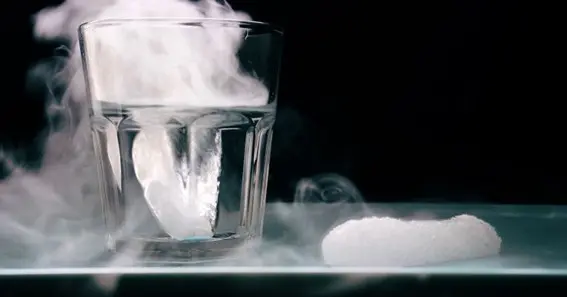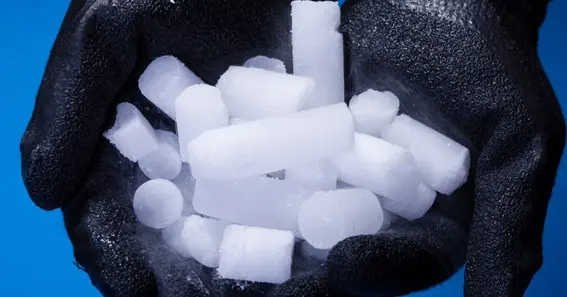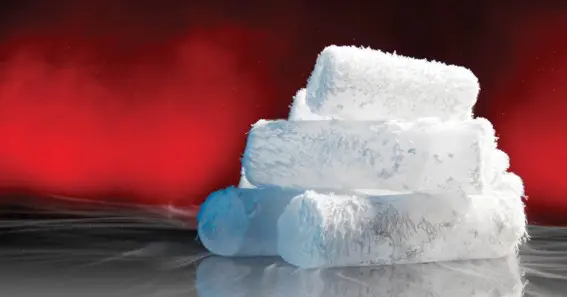What is dry ice made of? Dry ice is solid CO2, similar to ice which is solid water. With this intriguing question, we enter the world of unusual things. Sublimation converts this unique substance from solid to gas under normal air conditions.
Dry ice’s unusual properties make it helpful for stage effects and food preservation, making it popular. This article further discusses on what is dry ice made of, how it is manufactured, and its many uses to discover its unique and useful properties.
What Is Dry Ice Made Of?
Dry ice is exclusively carbon dioxide, a natural gas. No taste or smell of CO2. We consume it, and plants turn it into food. This gas solidifies into dry ice by cooling and pressing CO2. Water ice melts into water. Unlike liquid, dry ice sublimates from solid to gaseous. Sublimation occurs at -78.5°C (-109.3°F), which can cause frostbite. This should have given you a basic understanding on what is dry ice made of.
Dry ice is made from solid carbon dioxide, which sublimates directly from a solid to a gas without becoming liquid.
Unique Properties Of Dry Ice

Knowing about what is dry ice made of, you can find it’s properties quite unique. There are several differences between dry ice and other substances. Its ability to sublimate makes it ideal for cooling and freezing. Regular ice melts into a puddle. However, dry ice melts into CO2 gas without residue. This characteristic is useful when keeping food or doing scientific investigations.
Another feature of dry ice is its coldness. It freezes quickly at around -78.5°C, making it a good coolant for when standard cooling isn’t enough. Due to its extreme cold, dry ice can swiftly freeze food, preserve biological samples, and create false fog for performances. Sublimation releases gaseous CO2, which pushes oxygen out of enclosed spaces, helping insect control and chemical processes.
Manufacturing Process Of Dry Ice
Now after knowing what is dry ice made of, next let’s discuss about its manufacturing process. Dry ice is made by obtaining CO2 gas from natural or industrial sources. Squishing and cooling the gas turns it into a liquid. Released from pressure, liquid CO2 spreads swiftly and cools, becoming snow-like. This CO2 snow is collected and compacted into blocks, pellets, or slices, depending on its usage.
Dry ice is made under strict standards to ensure purity. Pollutants must be removed to ensure product safety, especially in food and medicine. Thicker dry ice with a high sublimation energy can absorb a lot of heat before converting it into a gas, making it a good and efficient cooling method.
Co2 Extraction And Compression
CO2 is collected from ammonia and natural gas facilities first. Gas is crushed under high pressure to become liquid. Pure CO2 is essential since impurities can render dry ice unsafe and ineffective.
Expansion And Cooling
Once CO2 is liquid, pressure drops to increase quickly. CO2 cools so much that it becomes snow-like. Process monitoring ensures that CO2 is at the proper temperature and consistency.
Molding And Shaping
CO2 snow is squeezed into different shapes and sizes depending on its application. This might range from large factory cooling blocks to little shipment or cleaning bits.
Applications Of Dry Ice In Various Industries

Due to its properties, dry ice is valuable in many fields. It’s utilized in the food industry to transport and store perishable items without water contamination. Medical professionals use dry ice to transport organs, biological samples, and vaccinations at low temperatures.
Entertainment professionals utilize dry ice to create fog in movies and shows. In water, dry ice sublimates into a thick, white fog that is lovely and safe to use in tiny spaces.
Safety Considerations When Handling Dry Ice
Due to its coldness and CO2 gas toxicity, dry ice should be handled carefully. Gloves and tools are essential for handling dry ice to avoid frostbite. People can suffocate when dry ice sublimates into carbon dioxide gas, pushing oxygen out of tiny spaces. Airflow is essential when using dry ice inside. Sublimating CO2 can blow airtight containers apart, so never keep it in them.
Environmental Impact Of Dry Ice
Many industrial operations produce CO2, which is used to make dry ice, which is more environmentally friendly than other cooling methods. However, manufacturing and using dry ice release CO2.
It is crucial to consider where CO2 comes from and how effectively the generation process works. Dry ice should be used responsibly, and CO2 should be recovered and recycled from industry processes to minimize its environmental impact.
Innovations And Future Prospects For Dry Ice
Because of its versatility, dry ice inspires fresh ideas in numerous industries. Most dry ice production developments in recent years have focused on CO2 collection and energy efficiency.
Researchers are also investigating novel uses for dry ice, such as preserving historical objects and controlling pests in agriculture. Much work is being done to make dry ice more environmentally friendly and discover other uses.
Conclusion
Dry ice, formed of solid carbon dioxide, is a versatile substance. Its capacity to sublimate from solid to gas makes it valuable in medical transport and food preservation. Due to its coldness and danger, dry ice is beneficial but must be handled carefully. As technology improves, dry ice production and use change.
This means dry ice will be used more creatively in the future. Dry ice’s unique qualities make it a unique way to preserve food or create an alien-looking fog. This article should have given you with enough information on what is dry ice made of.
FAQ
What Is The Origin Of Dry Ice?
CO2 sticks together to form dry ice.
How Is Dry Ice Made?
Scratched and cooled CO2 gas becomes liquid dry ice. The liquid grows and solidifies.
How Can You Work Safely With Dry Ice?
Wear gloves, use tools, ensure airflow, and avoid airtight items.
Can You Cook With Dry Ice?
Dry ice carries and preserves food since it leaves no residue.
What Are Some Unusual Dry Ice Uses?
Theaters utilize dry ice to generate fog, clean with dry ice blasting, and in some medical and commercial contexts.
Sources:








